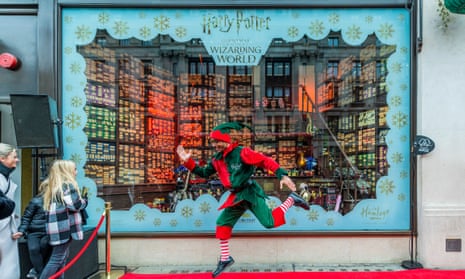Retail sales in Great Britain rose for the first time in six months in October as consumers started their Christmas shopping earlier than usual to avoid missing out if there was a shortage of goods.
The total volume of goods bought rose by 0.8% last month, according to the Office for National Statistics, compared with flat sales in September, driven by a rise in spending on toys and clothes. Economists had forecast a smaller rise in sales of 0.5%.
Retailers reported that early Christmas trading had boosted clothing store sales to within only 0.5% of pre-pandemic levels, while secondhand stores, toy shops and sports equipment stores also benefited from a scramble to avoid disappointment amid the global supply chain disruption.
The rise in October followed five months of no growth in the longest spending slump since 1996 after the easing of coronavirus restrictions this summer.
Food store sales volumes fell by 0.3% on the month, although they remain 3.4% above pre-pandemic levels. With the return of more people to town and city centres, online sales as a proportion of overall retail sales fell to 27.3%, the lowest level since the start of the pandemic. However, it remains significantly higher than pre-Covid, suggesting a permanent shift to higher levels of internet shopping after the pandemic.
British households are facing rising inflationary pressures, which are pushing up the cost of goods and services, driven by higher energy prices, in a development expected to squeeze consumer spending in the coming months.
Household energy bills are expected to continue to rise, while benefit cuts and planned tax rises from the government will further erode consumers’ disposable income.
Helen Dickinson, the chief executive of the British Retail Consortium, said the sector was putting in a gargantuan effort to ensure food and gifts were ready for Christmas but that the supply chain disruption and staff shortages were pushing up costs and creating some gaps on the shelves.
“Retailers are prioritising Christmas essentials, and many have laid out their festive offerings a little earlier to ensure everyone has time to buy treats and decorations before the big day,” she said.
With a rise in spending earlier than usual, retailers are hopeful that demand will continue through the coming months. “However, challenges remain, with higher prices looming and many households facing rising energy bills,” Dickinson added.
Separate figures from the ONS showed the government borrowed more than expected in October despite the end of the furlough scheme a month earlier and as cuts to universal credit were imposed.
The government’s budget deficit – the gap between spending and income – was estimated to be £18.8bn in October, only £200m lower than the same month last year when borrowing hit a record high for the month amid the fallout from Covid-19.
With a stronger performance in the public finances throughout most of this year, City economists had forecast borrowing of £13.8bn.
However, higher levels of inflation and increased spending linked to the government’s Covid-19 vaccination programme led to a weaker performance than expected in October. Against a backdrop of rising inflationary pressure, debt interest payments rose from £4.8bn in September to £5.6bn in October alongside an increase in the retail price index measure of inflation, which pushed up payments on index-linked debt.
Public sector borrowing for the financial year to October was estimated at £127.3bn, more than £100bn lower than the same point last year, although still the second-highest year-to-date borrowing figure on records dating back to 1993.
The chancellor, Rishi Sunak, said the government had supported businesses and households throughout the pandemic but this had left the country with a higher level of national debt.
“It is right that we now strengthen our public finances for future generations – so at the budget last month I set out new fiscal rules which will keep debt on a sustainable path in the years to come,” he said.
